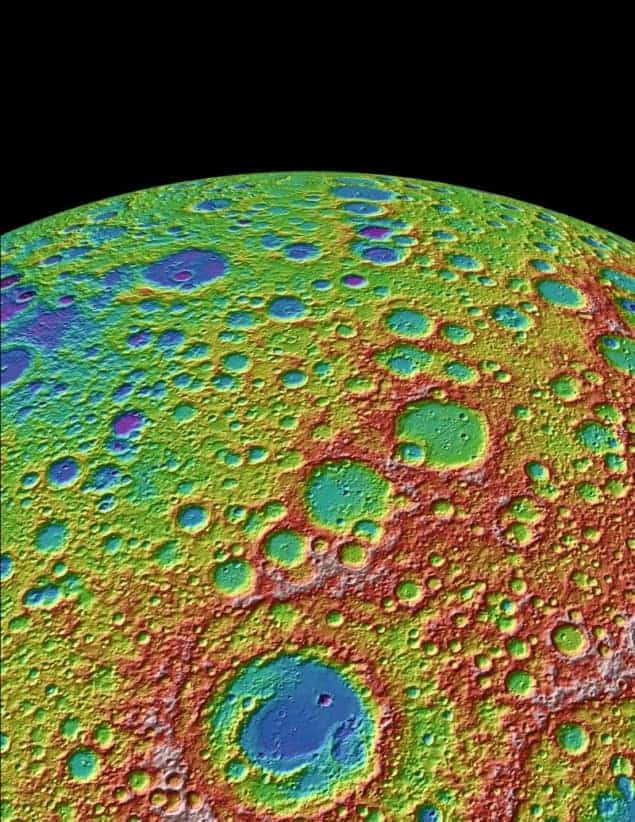
The geology of the Moon and the dynamics of the early solar system are much clearer now thanks to three new studies of the lunar surface by NASA’s Lunar Reconnaissance Orbiter (LRO). As well as providing insight into how and when lunar craters formed, the LRO has given researchers the opportunity to investigate the complex geological history of the Moon.
The Moon formed about 4.5 billion years ago and its surface holds a wealth of information about the chaotic history of our solar system – which formed just 50 million years earlier.
“Much of the scientific importance of the Moon arises from the fact that its ancient surface preserves a unique record of conditions in the first billion years of solar system history that more active planets, such as Earth and Mars, have long lost”, says Ian Crawford of the earth and planetary sciences department at Birkbeck College London, who was not involved in the research. “Studies of the Moon are therefore important for improving our understanding of the early history of the Earth–Moon system, and thus of Earth itself, as well as of the Solar System as a whole.”
Launched in June 2009, NASA’s LRO is fixed in a low orbit around the Moon and is currently acquiring a 3D map of the lunar surface using a number of different instruments.
Oldest regions of the moon
The global distribution and frequency of lunar craters was the focus of a study by researchers from Brown University, the Massachusetts Institute of Technology, and NASA Goddard Space Flight Center. Led by planetary geologist James Head, the team compiled a comprehensive catalogue of 5,185 lunar craters with a diameter of 20 km or larger. This was done using data from the Lunar Orbiter Laser Altimeter (LOLA), one of a suite of instruments onboard the LRO.
This catalogue makes it possible to identify both the oldest regions of the moon, and the oldest basins and craters. Such information is crucial for planning future missions to the Moon, which could be sent to such craters to collect samples. Analysis of this material could prove invaluable in determining early solar system dynamics and fully understanding the Moon and other bodies.
The team also investigated the size and frequency distribution of the material that struck the Moon during its early bombardment about 4 billion years ago. Craters present on older surfaces were found to be mainly caused by larger projectiles. This lends credibility to a previously suggested theory that the ratio of larger and smaller objects striking the Moon differed during the first billion years of its existence. In all, the findings “are telling us something about the infancy of the solar system,” says Head.
Seeking out silicics
Two new studies of the minerals present in lunar soil and rocks have also been made using the LRO. One study was led by Benjamin Greenhagen of NASA’s Jet Propulsion Laboratory and analysed data from the LRO’s Diviner Lunar Radiometer Experiment (DLRE), which detects infrared radiation. As such, it is able to distinguish between different rock types and was used by Greenhagen and colleagues to identify regions of the lunar surface rich in silicics – igneous rock that forms from magma.
The other study was led by Timothy Glotch of Stony Brook University and focused on four silicic-rich areas. They found that the mid-infrared spectra from these regions can be best explained by the presence of certain compounds – specifically quartz, silicon-rich glass and alkali feldspar. The wide variety of landforms with these silic-rich regions suggests that magma once flowed both above and below the lunar crust. According to the researchers, this is a much greater level of igneous and geological activity than had been previously thought.
Targeted studies are next
“LRO is giving us the highest resolution of imaging of the surface from orbit, and new insights into the processes that formed the lunar surface. It is showing that the Moon is very geologically diverse,” says Neil Bowles of the University of Oxford, who worked on both mineralogy studies. “In the future, LRO will be going into a targeted science mode allowing more time to examine specific regions revealed during the initial mapping phase of the mission.”
The work is described in three papers published in Science.



